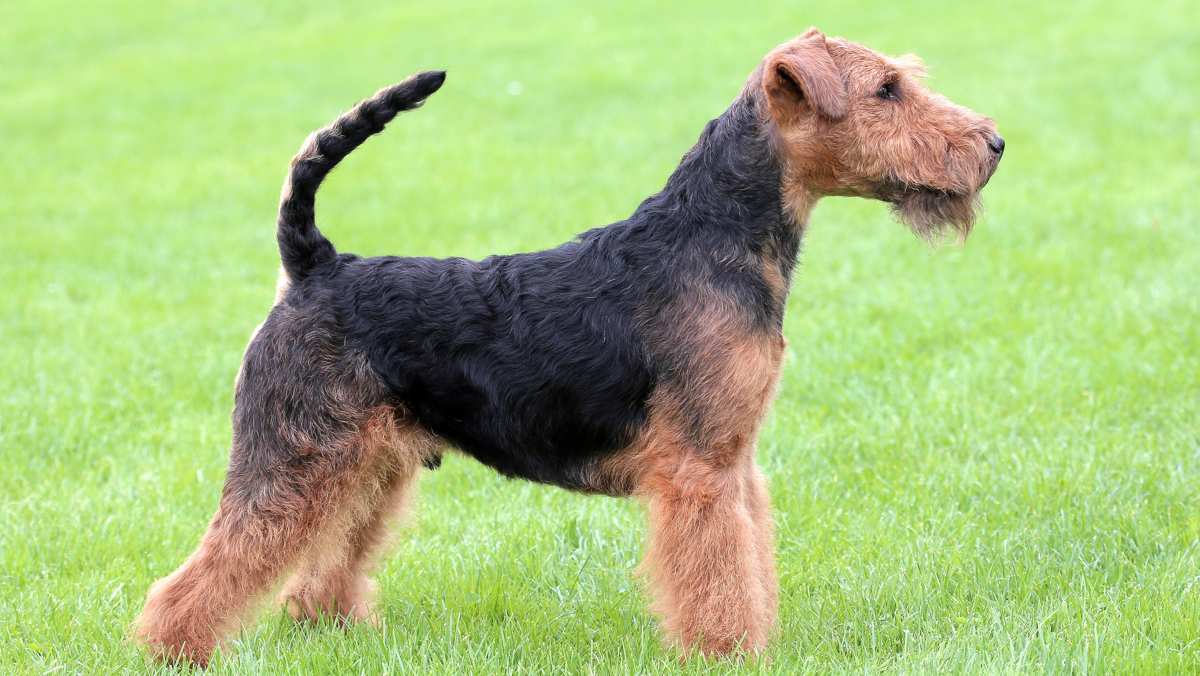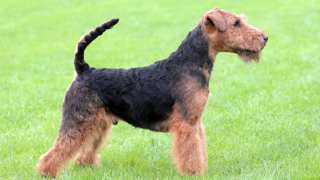The Welsh Terrier is a hardy little dog that resembles other breeds in its family such as the Airedale Terrier and the Lakeland Terrier. The characteristic black and tan coat, rectangular head and bold beard make these guys a smart looking breed. A great companion for the traveler, this dog was a favorite of Caroline Kennedy. They can live indoors or out but ideally spend equal time in both arenas. A fenced yard or at least a leash is necessary and members of this breed become easily bored if not exercised. They are an all around friendly and playful breed towards kids, pets, and even strangers. The owner must have the patience and time for consistent training. These dogs hardly ever shed if their coats are properly brushed and clipped. They are generally free of major health problems and live around 12-14 years.
Welsh Terrier Breed Details
The Welsh Terrier, a member of the Terrier group of breeds, was developed in Wales in the late nineteenth century to hunt foxes, badgers, and other game. Members of this breed will be good with busy families and singles; since they shed very little, they will be good for allergy sufferers as well. These dogs are also known to be excellent traveling companions. A few Welsh Terrier facts: they're hypoallergenic, medium-sized, and have medium-length coats that are normally black and tan in color. Here are some positive and negative breed characteristics:
PROS:
- Intelligent and alert
- Playful and friendly
- Low to moderate maintenance needed
- Great with kids and strangers
- Hypoallergenic
- Affectionate and fairly even-tempered
- Excellent health
- Exceptionally intuitive
- Socializes fairly well with other dogs
CONS:
- Can be stubborn and independent
- Barks/howls fairly often
- High exercise requirements
- Tendency for digging and chewing
- High prey drive means they will chase cats and other small pets
- High wanderlust potential; tall fence (with underground reinforcements) recommended
- Can be difficult to train
- Not suitable for first-time owners
Purebred
12 - 14 yrs.
14 - 15 in.
20 - 21 lbs
OverallFamily FriendlyChild FriendlyPet FriendlyStranger Friendly
Easy to GroomEnergy LevelExercise NeedsHealthShedding Amount
Barks / HowlsEasy to TrainGuard DogPlayfulnessWatch Dog
Apartment DogCan be AloneGood for Busy OwnersGood for New OwnersIntelligence
Welsh Terrier Breed Description
This small breed shows little difference between males and females. Members stand about 15 inches and the shoulders and weigh up to 20 pounds.
Overall, for a terrier, members of this breed are well-mannered but still have the vigor and liveliness so characteristic in them. They need moderate playtime so those without time, energy or a yard to exercise them should not consider this type of dog. Welsh Terriers are fairly affectionate and will be friendly and playful with children and other pets. They are considered alert dogs due to their hunting instincts but will likely be friendly to strangers as well.
Members of this breed will require a low-medium amount of maintenance. The rough, wiry coat will need to be brushed around three times per week and clipped every 3 months. To keep them from becoming bored they will need a long daily walk or ample outdoor playtime. Training will not be terribly difficult due to the intuition and intelligence of this breed, however, their stubborn and curious personality ensures that consistency will be the key to success.
Welsh Terrier Breed History
Welsh Terriers are one of several similar looking breeds descended from Britain's Black and Tan Terrier; it is sized between the Airedale and Lakeland Terriers. The first records of this particular breed occurred during 1881-1885, in black and white photos of these dogs at local dog shows in Carnavon, Wales. They are employed as hunters of foxes, badgers, and even otter in their homeland. Members of this breed were imported into America in 1888 and classified as 'miscellaneous". Until the very late 1800s they were still classified as Old English Terriers or Black and Tan Wire-Haired Terriers. This breed was finally set apart and recognized by the AKC in 1988 and the Westminster Kennel Club in 1901.
Welsh Terriers, most notably, have a wiry black and tan coat that protects from wind and dirt; the undercoat is short and soft. The tan coloration covers the head, legs and underside while the black envelops the back in a "jacket" style. The head is rectangular but overall the body should appear square. The lively eyes, small folded ears and considerable beard give this terrier a smart and somewhat animated look. This breed has long legs and typically sports a docked tail that is held up in the air.
The images below represent the coat colors and patterns associated with Welsh Terriers.
Black Grizzle and Tan
The Welsh Terrier has little variation within the breed. In fact, canine DNA organizations contend that these dogs are comparatively few in number, and thus all share the same lineage; because of this, there is little difference in these dogs' genetic makeup. Nor is there much variation in regards to coat type; double-layered, wire-haired Welsh Terriers with abundant facial hair are strictly the norm.
Size amongst dogs of this breed is consistent as well: an average of 15 inches in height and 20 pounds in weight. Though breeders may offer Toy or Miniature Welsh Terriers for sale, and the dogs are as small as 10 inches in height and 12 pounds in weight, these "mini Welsh Terriers" are undoubtedly crossbreeds.
Welsh Terrier Temperament
Owners and experts contend that this breed is a great choice for an owner that travels due to its adventurous yet mannerly nature. This is a well-behaved breed although they have the hallmark spirit and vigor of a terrier. They are also very intuitive and therefore are able to rein in their curiosity to an extent. Most agree training is attainable without too much difficulty as terriers are intelligent and the Welsh Terrier is calmer than most. They can take on an energetic and stubborn attitude that requires the owner to be persistent with this training over their lifetime. This breed should ideally divide its time between indoors and outdoors but is capable of living solely in either.
Welsh Terrier Maintenance
Members of this breed will require a low-medium amount of maintenance. The rough, wiry coat will need to be brushed around three times per week and clipped every 3 months. To keep them from becoming bored they will need a long daily walk or ample outdoor playtime. Training will not be terribly difficult due to the intuition and intelligence of this breed, however, their stubborn and curious personality ensures that consistency will be the key to success.
These dogs typically shed very little if the appropriate attention is given to grooming. Their wiry haired coats need to be brush a few times per week to keep them free of tangles. Clipping or stripping should be done 4 times per year.
This small yet tenacious dog has moderate exercise requirements that should be met every day. Although he is small, this rugged companion will keep up with you on your daily walk or hike with his characteristic, effortless "terrier trot". Like most terriers, Welsh Terriers need daily outdoor playtime but, if bored or left alone for too long, may be prone to digging and barking. They would also enjoy hunting activities but due to this tendency should be kept on a leash during walks. Other favorite pastimes include chasing and swimming.
Members of this breed make excellent travel companions so they should be able to withstand any changes within their living environments for moderate amounts of time. They are capable of living calmly and peacefully indoors since they are more well-behaved than other terriers, but they should have daily outdoor playtime to expend their moderate energy. A fenced yard is recommended.
Welsh Terriers are pretty healthy dogs and live quite long for their type. They have no major health issues but can be predisposed to eye problems such as cataracts or lens luxation resulting in cataracts. Patellar luxation is also somewhat common. This breed has been known to live as long as 14 years.
Welsh Terrier Health Concerns
Below are potential health concerns associated with Welsh Terriers.



